“Supply chain.” Although it’s a term most people rarely used before 2020, it’s certainly a common point of discussion these days. In construction, however, the supply chain has always been a key factor driving industry cycles, depending upon the availability and cost of tangible building materials. Supply chain challenges have definitely evolved over the past few years, though, followed by cross-industry reactions and economic fallout.
Although the construction environment seems to shift on a daily basis, there are actions that builders can take to walk through this current reality with confidence. Here, Chad Collins, owner of Collins Design Build, a custom homebuilder in central North Carolina, provides some insights and tactics to help industry professionals survive and thrive.
Perfect storm
It’s nothing unique for general contractors, tradespeople, and builders to have a solid grasp on supply forecasting with regard to project scheduling and management—success and reputation depend on it. Through the years, economic cycles have been the norm, with various macro and micro issues impacting each economic phase. So, construction industry professionals have learned how best to ride the waves.
But then came the Great Recession in 2008. Because of the development boom just before the recession, inventory was high, and it seemed builders couldn’t give lots away. With lack of activity, the industry workforce declined, initiating what would become a future labor crisis. Even as demand slowly increased over the next decade—eventually booming again in 2019—a home shortage was on the rise. Then came 2020 and a global pandemic that changed everything. These conditions all set the stage for a perfect storm involving product availability, skyrocketing costs, and labor shortages, all leading builders to start fighting the proverbial undertow.
Supply woes
The response to the pandemic shut down a huge portion of businesses. And although construction-related industries were deemed “essential,” supplies became much harder to come by, with significant delays in shipping. Six to eight weeks became 26 to 30 weeks. But builders were aware of most delays and could plan accordingly in their forecasting—for now.
During 2020, rising costs for building supplies could generally be attributed to basic economics—demand was high, and supply was low. But 2021 brought historical levels of inflation (4.7%), which impacted every product and service across the board. Combining inflation and continued availability issues, lumber prices increased 142% during 2021 alone1. And the overall year-over-year increase in construction materials rose nearly 20%2.
In 2022, supply issues went beyond high prices and long waits to include some products and parts simply being unavailable. The supply chain became a moving target, and so did prices. An order could be made at one price, but when the bill came in, the cost would be three to five times higher. Although the industry had gotten away from deposits throughout the 2000s, it became imperative to: (1) secure a product at a particular price, and (2) to ensure you were in line for that order to be fulfilled. This made things difficult for smaller builders, because deposits could quickly add up to hundreds of thousands of dollars—and that’s before getting any bank draws. For some builders and trades, this unpredictable price-changing and availability issue was devastating. They simply couldn’t do the job for the price quoted to the customer, and many businesses suffered greatly.
Lacking labor
Of course, the ongoing (and worsening) labor crisis also impacts supply chain challenges, with every trade reporting significant shortages, which affects project timelines and projections. The workforce is getting older too, with 22% over age 55 and an average age of 42 (2021). So, it’s imperative that the industry does everything possible to entice young people into construction. But it’s not just the job-site feeling the pain. The so-called “Great Resignation” and compounding regulatory aspects have pulled workers from shipping and trucking, generating another facet of slowdowns and stoppages.
Action steps to survive—and thrive
All this background information sets what could be a dim stage. However, the construction industry has been around for millennia and has survived plenty of proverbial cyclones. And it will continue to survive. So, at this moment in time, what are some practical things builders and tradespeople can do to adapt and prosper? Here are five ideas that are sure to inspire.
-
- Get involved in your state HBA and local trade associations. Professionals in the construction industry must weather this season together. These organizations are doing important advocacy work on our behalf and we all must take part in the work. Plus, it provides access to industry insights, economics, and forecasts to inform decisions and project management.
- Be fully transparent. Whatever industry insight is available (from the HBA, for example) should become part of client conversations. When the customer has a better understanding of the environment and outlook, builders and tradespeople can be straightforward in creating budgets and setting contingencies. So, when those “unknowns” become known (along with their impact), conversations can be had around changing selections of items that can be more controlled. Because every aspect of building is swirling with uncertainty, from permitting to fuel to labor, this honest transparency allows for projects to be forecast and managed with integrity.
- Include customers in the decision-making process. This action step goes alongside being transparent. Every project has expected variables, with contingencies being a regular line item. But in the current situation, it’s ideal to discuss every line item with customers, including availability, timelines, expected cost increases over time, etc.
- Get creative. Most builders have their go-to trades, which are often small local teams. When prices escalated, many of these businesses didn’t have enough cashflow to pre-purchase supplies. Most builders, however, have the capability and buying power to purchase those materials on their account and float the costs for the smaller trades. This is just one way to work together as we all figure out how to get through to what’s next.
- Nurture your networks. The importance of connectivity cannot be overstated. Connecting with peers, competitors, suppliers, and contractors to find out what they’re doing to adapt during these unpredictable times is key. Share innovative ideas and determine ways to support each other. Form local alliances in support of smaller businesses. Be encouraging—kindness, integrity, and collaboration help create long-term success.
To learn more about this important topic, check out the latest episode of our podcast, Building Progress, where host Katie Mariani sits down with Dr. Robert Dietz, chief economist and senior VP for Economics and Housing Policy for the National Association of Home Builders, and Mark Martin, owner of Sandmark Custom Homes Inc. and former president of the NC Home Builders Association, to discuss supply chain issues and how the construction industry is being affected by supply, labor, costs, and other factors. Listen here or download from your app store. ow.ly/UjQU50IBWVP
2. https://www.constructiondive.com/news/report-materials-prices-soared-20-in-2021/617198/




 Find an
Find an